Pantex Blog
Pantex Night at Discovery Center
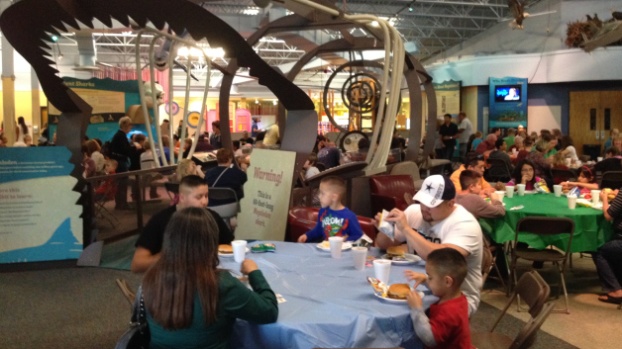
More than 500 Pantexans and their families attended Pantex Night at the Don Harrington Discovery Center Sunday. Pantex volunteers served hamburgers and hot dogs at the science center event, which featured an exhibit on the extinct Megalodon shark, as well as a mummy in the Lost Egypt exhibit. B&W Pantex sponsored the shark exhibit.
Wild Pantex - Nuisance Animals: Wrong Place, Wrong Time
Article by Jim Ray, Pantex Wildlife Biologist/Scientist
I had just got to work, settled in at my desk, read a few e-mails, and then my phone rang. The caller proceeded to tell me they were trying to work, but were interrupted by the presence of a rattlesnake. I strapped on my snake leggings, hopped in my truck and headed out toward the location, which involved a 10-15 minute drive.
Actually, snake calls are not that uncommon at Pantex. After all, we are situated out in the prairie. Most nuisance snake calls involve the prairie rattlesnake, bullsnake or checkered gartersnake. But, sometimes it will be an oddity. For example, the only eastern hognose snake ever documented at Pantex was captured in a building during a similar nuisance animal response.
Upon arrival where the rattlesnake was, several workers helped direct me to the snake, which was coiled in a dark corner of the building. True to form, it was a prairie rattlesnake which is the only rattlesnake species documented at Pantex, or that would even be expected in our habitats. With snake tongs, I safely captured it and placed it in a five gallon bucket. I carefully slid a second bucket down into the first, creating a safe holding container for the snake.
Our nuisance animal management program is guided by the Management Plan for Nuisance Animals at Pantex Plant, which was approved by Pantex’s National Nuclear Security Administration Production Office. So, what makes an animal a nuisance? As regards native animals, our use of the term “nuisance” applies only to situations; in other words, when an animal is impacting work, is in a location that is of cause for concern or is acting in a manner that is a cause of concern. Usually, the animal is fine; it is just in the wrong place at the wrong time.
The rattlesnake, of course, has special considerations because it is venomous. But, had the rattlesnake simply been observed crossing a road out in the backcountry, even it would have been left alone. Meanwhile, the peaceful mourning dove sitting on a nest located on the engine block of an important piece of equipment might be considered a nuisance until the pair successfully fledge their young. Other common nuisance animal situations at Pantex include striped skunks under buildings, the presence of feral cats or stray dogs, feral pigeons nesting over work areas and cottontail rabbit and wood rat damage to vehicle wiring.
When we need outside support with situations, we have a great relationship with the U.S. Department of Agriculture’s Wildlife Services, the Texas Parks and Wildlife Department and the U.S. Fish and Wildlife Service. We hold a permit from the Texas Parks and Wildlife Department to trap and relocate nuisance fur-bearing animals, such as raccoons and opossums.
I just never know what a day may hold in terms of nuisance animal situations. Some days I may be able to focus on research or other “planned tasks,” while other days may find me responding to different nuisance animal calls, including setting traps and moving animals. As for today’s subject rattlesnake, following capture, she was transported to a prairie dog colony a few miles to the west and released unharmed.
Please feel free to share this link with others that enjoy wildlife or that appreciate entities that take great strides to contribute to wildlife conservation.
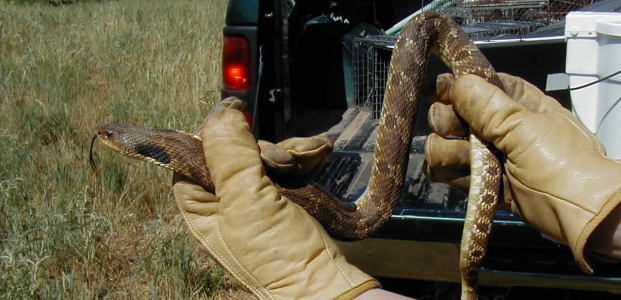
Photo: This large, although harmless, eastern hognose snake was captured on a nuisance animal response trip and relocated to suitable habitat on Pantex. This individual remains the only one of its kind ever documented at Pantex.
Wild Pantex – Bobcat Work Makes The News
Article by Jim Ray, Pantex Wildlife Biologist/Scientist
Pantex and West Texas A&M have been working on bobcat research since 2009. Actually, this work has since transcended from "research" to "management" of the cats. Sunday, the work made the Amarillo Globe-News.
Enjoy the story here.
Please feel free to share this link with others that enjoy wildlife or that appreciate entities that take great strides to contribute to wildlife conservation.
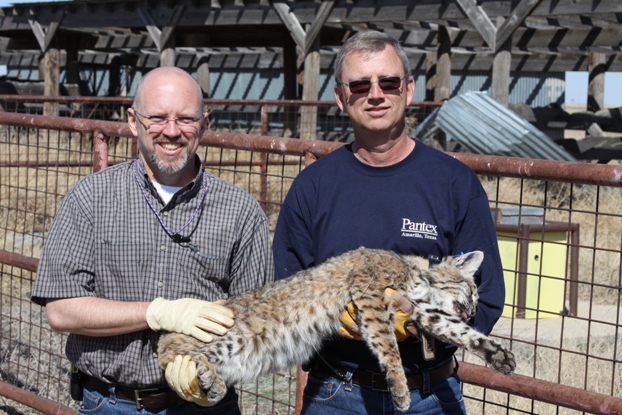
Co-Principle Investigators, Dr. Raymond Matlack, West Texas A&M University, and Jim Ray, pose with a large male bobcat captured in their study area.
Pantex Engineers Host S'More Engineering
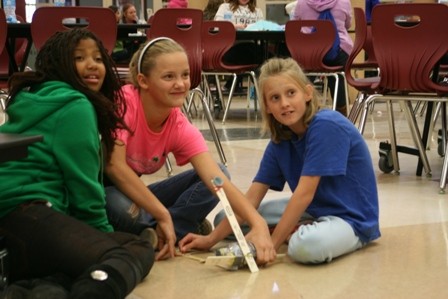
A group of young women engineers from Pantex spent their Saturday putting on an annual engineering workshop, known as S’More Engineering, for Amarillo-area Girl Scouts.
The engineers helped the Girl Scouts with several projects that illustrated engineering concepts, such as an egg drop that had the girls building a structure that would allow an egg to survive a one-story drop and an Angry Birds activity that saw them build catapults and other launching devices that re-created the popular mobile game.
The program started last year as a way to generate interest in engineering among young girls and encourage them to pursue careers in technical fields.
“It is very encouraging to see so many girls come out and take an active interest in engineering,” said Pantex process engineer Savannah Gates, who helped develop the Girl Scouts program. “These activities are so much fun, but they also teach important lessons that we hope will be valuable in their lives.”
B&W Pantex supports numerous activities throughout the year designed to encourage a love of science and math among area youths.
This year’s event continued the trend of increasing attendance, up by 50 percent over the last workshop, and interest by Girl Scouts, including several parents who participated in the event.
“It’s such a great opportunity for the girls to meet the Pantex engineers and work with them on these projects,” said Kathi Schutz, area director for the Girl Scouts of the Texas Oklahoma Plains. “They’re very hands on, and the girls see them as mentors that are taking an active interest in them.”
Wild Pantex – The Scoop on Pantex and Wildlife
Article by Jim Ray, Pantex Wildlife Biologist/Scientist
Recent media coverage on our wildlife work at Pantex elicited the following comment in the Amarillo Globe News. “That’s cool….but, I don’t get the connection between what Pantex does and them studying birds.” Well, that’s pretty easy to answer so I’ll do it here.
Good Stewards/Good Neighbors
First off, think U. S. Department of Energy’s (USDOE) Rocky Flats facility in Colorado. Many of the directives that flow down to my management and division stem from environmental issues at Rocky Flats: the resulting public perception, the reactions that followed, and then the eventual closing of that facility – forever. Trust me, the Pantex Plant, its employees, and the surrounding communities want no part of something like that. We want to be here for the long run, continuing our roles in national security and our place in the local community. Thus, concern for, and protection of the environment is embedded in our company’s strategic plan, our environmental policy, and in our nuclear safety culture.
The Pantex wildlife program operates within a rather broad directive from USDOE, “Land use planning and stewardship responsibilities will be implemented consistent with the principles of ecosystem management and sustainable development.” What we take out of this, and additional guidance, is that we are to use state-of-the-art management practices to manage and maintain our shortgrass prairie and playa wetland-centered ecosystem and the native wildlife resources that inhabit it. This factors into all the various parts of our program including nuisance animal management.
Although it is easy to think that research goes above and beyond that basic mandate, research is in order when questions are needed to address management needs. Research contributions and collaborations help make us good stewards and neighbors, and USDOE has been very supportive of our efforts.
Other Supporting Directives
The Executive Order, Responsibilities of Federal Agencies to Protect Migratory Birds, came about in 2001 and gives us a strong driver to manage habitat for birds, conduct research, promote birds through outreach, and participate in partnerships that conserve or study birds. Additionally, much of our current work on birds is part of the monitoring that we promised the U. S. Fish and Wildlife Service and Texas Parks and Wildlife Department that we would perform, as responsible stewards, in association with the Pantex Renewable Energy Project.
Thus, our research collaborations, and the resulting opportunities for sharing of information through publications, presentations and interactions with the media are all supported by agency directives, and the kind of responsible stewardship that we want to continue to display into the future.
Please feel free to share this link with others who enjoy wildlife or appreciate entities that take great strides to contribute to wildlife conservation.
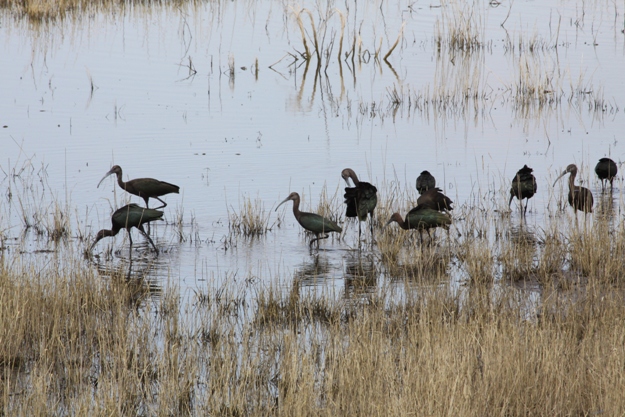
These white-faced ibis take time to feed on aquatic invertebrates in Playa 1 at the Pantex Plant.
